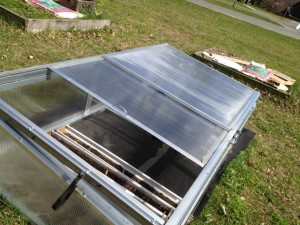 Behind the middle school buildings, on a small plot of land, two students and their advisor were starting off activities period by smelling a large box of old banana peels, oranges, and apple cores.
Behind the middle school buildings, on a small plot of land, two students and their advisor were starting off activities period by smelling a large box of old banana peels, oranges, and apple cores.
“Phew!” said Joey Newlin ’12 as he peered into a large green barrel.
“Anarobic decomposition smells like this. It’s like a sewer smell,” said Jane Lucia, the gardening club’s faculty advisor. “Turning actually mixes it, aerates it, and keeps that stench away.”
It was spring on The Williston Northampton School campus and the members of the gardening club were out to inspect their food garden, give the mulch a good turn, and transfer seedlings from the gutters where they had sprouted to the cold frame, where they’d grow into carrots, beets, and a cold weather lettuce called mache.
The club, which started in fall 2007, has a small, but dedicated, membership that gathers each year to experiment with growing and composting techniques, as well as encourage community involvement in gardening.
Among the five members this year are Newlin and Nick Pattison ’14, who were on hand in early April to transfer seedlings and refresh the compost bins.
“I just like getting dirty,” said Pattison, as he loaded leaves into a rotating drum. “I live around a lot a farm fields and it helps me have a little piece of home around here.”
“Learning how to grow your own food is really cool,” he added. “We’re so disconnected from it today.”
The club’ s five members, plus Lucia, who teaches science at the Middle School, collect prep scraps—such as grapefruit rinds, egg shells, and carrot and pineapple tops—from the dining hall, leaves from faculty yards, and community additions such as sawdust to create the compost. The compost, in turn, is used in the garden during the warmer months.
“There’s a sign that says ‘Feed me’ where people put their stuff,” said Newlin. “We just move that from bin to bin.”
Last year, the club took on a load of llama poo, which Lucia said helped the food garden produce a small bumper crop. The club celebrated in the fall by harvesting and eating their own carrots, radishes, and salad greens. ‘
In addition to the raised beds for plants, and bee boxes, club members built a cold frame this year to get their vegetables started early, and have been looking into alternatives to peat pots—since the harvest of peat destroys wetlands—including pots made out of cow pies and paper, and reusable plastic gutters.
Through their involvement with the club, members have a chance to be creative with gardening methods. In turn, they receive what they describe as a “100 percent benefit”—the chance to eat vegetables straight from the ground.
“I benefit by eating food from the garden,” said Pattison. “I can just pick a carrot from it.”
While the hope is that the garden will produce a bountiful crop every year, Lucia said in an email that the point of the garden is “not really about the abundance of food but more as confirmation of the success of students’ ideas, investment and efforts.”
Lucia said she also hopes a new sign for the garden, created by Pattison over spring break, will help invite others in the community to stop by and get involved.


